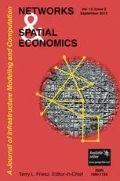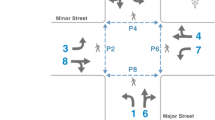Abstract
A critical problem faced by railways is how to increase capacity without investing heavily in infrastructure and impacting on schedule reliability. One way of increasing capacity is to reduce the buffer time added to timetables. Buffer time is used to reduce the impact of train delays on overall network reliability. While reducing buffer times can increase capacity, it also means that small delays to a single train can propagate quickly through the system causing knock-on delays to trains impacted by the delayed train. The Swiss Federal Railways (SBB) and Swiss Federal Institute of Technology (ETH) are researching a new approach for real-time train rescheduling that could enable buffer times to be reduced without impacting schedule reliability. This approach is based on the idea that if trains can be efficiently rescheduled to address delays, then less buffer time is needed to maintain the same level of system schedule reliability. The proposed approach combines a rescheduling algorithm with very accurate train operations (using a driver-machine interface). This paper describes the proposed approach, some system characteristics that improve its efficiency, and results of a microscopic simulation completed to help show the effectiveness of this new approach. The results demonstrate that the proposed integrated real-time rescheduling system enables capacity to be increased and may reduce knock-on delays. The results also clearly showed the importance of accurate train operations on the rescheduling system’s effectiveness.









Similar content being viewed by others
References
Albrecht T (2007) The influence of anticipating train driving on the dispatching process in railway conflict situations. In: Hansen IA, Radke A, Pachl JP, Wendler E (eds) Proceedings of the 2nd International Seminar on Railway Operations Modelling and Analysis, Hannover
Albrecht T, van Luipen J, Hansen IA, Weeda A (2007) Bessere Echtzeitinformationen für Triebfahrzeugführer und Fahrdienstleiter. Eisenbahningenieur 58(6):73–79
Burkolter D, Herrmann T, Caimi G (2005) Generating Dense Railway Schedules, In Publishing House of Poznan University of Technology, Advanced OR and AI Methods in Transportation, pp 290–297
Caimi G, Burkolter D, Herrmann T, Chudak F, Laumanns M (2007) Design of a new railway scheduling model for dense services. In: Hansen IA, Radke A, Pachl JP, Wendler E (eds) Proceedings of the 2nd International Seminar on Railway Operations Modelling and Analysis, Hannover.
D’Ariano A, Pranzo M, Hansen IA (2007) Conflict Resolution and Train Speed Coordination for Solving Real-Time Timetable Perturbations. IEEE Transactions on Intelligent Transportation Systems 8(2):208–222
Eichenberger P (2007) Kapazitätssteigerung durch ETCS. Signal und Draht 99(3):6–14
Fay A (1999) Wissensbasierte Entscheidungsunterstützung für die Disposition im Schienenverkehr. Technical University Braunschweig, VDI Verlag
Fenix J, Graffagnino T, Sagot J-C, Valot C (2005) User centred design applied to increase timetable stability. In Proceedings of the 36. Tagung moderne Schienenfahrzeuge, Graz
Jacobs J (2004) Reducing delays by means of computer-aided ‘on-the-spot’ rescheduling. In: Allan J, Hill RJ, Brebbia CA, Sciutto G, Sone S (eds) Computers in Railways IX. WIT, Southampton, pp 603–612
Johner A, Luethi M (2007) The train departure process and its impact on the rail network performance. In Proceedings of the 7th Swiss Transport Research Conference, Ascona
Laube F, Schaffer H (2006) Specific working results about the rescheduling process and phases for the PULS 90 project. Internal working paper, SBB Bern
Laube F, Roos S, Wuest R, Luethi M, Weidmann U (2007) PULS 90—Ein systemumfassender Ansatz zur Leistungssteigerung von Eisenbahnnetzen. ETR Eisenbahntechnische Rundschau, 3/2007:104–107
Luethi M, Huerlimann D, Nash A (2005) Understanding the Timetable Planning Process as a Closed Control Loop. In: Hansen IA, Dekking FM, Goverde RMP, Heidergott B, Meester LE (eds) Proceedings of the 1st International Seminar on Railway Operations Modelling and Analysis, Delft
Mazzarello M, Ottaviano E (2007) A Traffic Management System for Real-Time Traffic Optimisation in Railways. Transportation Research Part B: Methodological 41B(2):246–274
Nash A, Huerlimann D (2004) Railroad simulation using OpenTrack. In: Allan J, Hill RJ, Brebbia CA, Sciutto G, Sone S (eds) Computers in Railways IX. WIT, Southampton, pp 45–54
Roos S (2006) Bewertung von Knotenmanagement-Methoden für Eisenbahnen. Master thesis, ETH Zurich
Stalder O, Laube F, Graffagnino T (2003) Increasing Performance of the Rail Network in the Heart of Europe: A Program for the Swiss Federal Railways. In Proceedings for the STECH’03: International Symposium on Speed-up and Service Technology for Railways and Maglev Systems, Tokyo
Vieira GE, Herrmann JW, Lin E (2003) Rescheduling Manufacturing Systems: A Framework of Strategies, Policies, and Methods. Journal of Scheduling 6:39–62
Wegele S, Schnieder E (2004) Automated dispatching of train operations using genetic algorithms. In: Allan J, Hill RJ, Brebbia CA, Sciutto G, Sone S (eds) Computers in Railways IX. WIT, Southampton, pp 775–784
Wuest R (2006) Dynamic rescheduling based on predefined track slots. In Proceedings of 7th World Congress on Railway Research, Montreal
Yuan J, Goverde RMP, Hansen IA (2004) Evaluating stochastic train process time distribution models on the basis of empirical detection data. In: Allan J, Hill RJ, Brebbia CA, Sciutto G, Sone S (eds) Computers in Railways IX. WIT, Southampton, pp 631–640
Acknowledgements
The authors would like to thank the Swiss Federal Railway Infrastructure Division, namely Dr. Felix Laube, Dr. Raimond Wuest, Samuel Roos, Oskar Stalder and Thomas Graffagnino, for funding this research and for their fruitful discussions, and also Prof. Ulrich Weidmann, Prof. Giovanni Longo and Adrian Johner for their cooperation and helpful support. The authors also thank the reviewers for constructive suggestions that helped improving substantially the quality of this paper.
Author information
Authors and Affiliations
Corresponding author
Rights and permissions
About this article
Cite this article
Luethi, M., Medeossi, G. & Nash, A. Structure and Simulation Evaluation of an Integrated Real-Time Rescheduling System for Railway Networks. Netw Spat Econ 9, 103–121 (2009). https://doi.org/10.1007/s11067-008-9085-4
Published:
Issue Date:
DOI: https://doi.org/10.1007/s11067-008-9085-4




